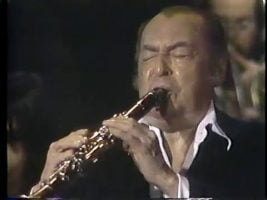In 1946, the classically inclined arranger Ralph Burns brought a three-part neo-Impressionist suite to bandleader Woody Herman called Summer Sequence.
As Gary Giddins notes in his superb book, Visions of Jazz (Oxford), Herman recorded the three parts in September ’46, when saxophonist Flip Phillips was the band’s chief saxophone soloist. But in the 78 era, three parts of anything was ill-fated. You needed four parts to fill four sides of two records. So Columbia, Herman’s label at the time, shelved the masters. [Photo of Ralph Burns by William P. Gottlieb in April 1947]
A year later, in the fall of ’47, Herman overhauled his band, commissioning arrangements that emphasized his saxophones. Herman’s newly revamped reed section initially featured Sam Marowitz (as), Stan Getz, Zoot Sims and Herbie Steward (ts) and baritone saxophonist Serge Chaloff. When Marowitz left sortly after, Herman stepped in to play the alto part. Burns was commissioned to write Part IV of Summer Sequence, which the band recorded on December 27, 1947, just days before the start of the second American Federation of Musicians’ recording ban. My guess is that with a paralyzing recording ban bearing down on the music industry that fall, Columbia exhumed everything it had in the vaults and prepared it for market. This included Summer Sequence, for which Burns was asked to write a fourth part.
The big surprise in Part IV came two minutes into the recording, when Getz (above) took a beautiful, yearning eight-bar solo that was considered revelatory at the time. And the melodic reed writing by Burns that followed Getz’s solo hinted at a new song waiting to be born.
By the time the recording ban ended in the fall of 1948, Herman had left Columbia for Capitol. Struck by the second portion of Summer Sequence Part IV,Herman had Burns re-arrange it as a new reed-centric song called Early Autumn. Getz was the featured soloist.
In 1952, Herman asked Johnny Mercer to write a lyric, and Herman wound up with a co-writing credit on the vocal version. Jo Stafford was first to record the song on June 24th, with Ella Fitzgerald coming next two days later on the 26th, and Herman recording his vocal version in July. Early Autumn quickly became a jazz standard.
https://www.youtube.com/watch?v=lGgQ9xBa1gs






More Stories
CD review: George Benson – Dreams Do Come True: When George Benson Meets Robert Farnon – 2024: Video, CD cover
The band was tight as ever. The Warren Haynes Band cuts loose: Video, Photos
Interview with Alvin Queen: Feeling Good – I heard these tunes played by … Video, new CD cover, Photos